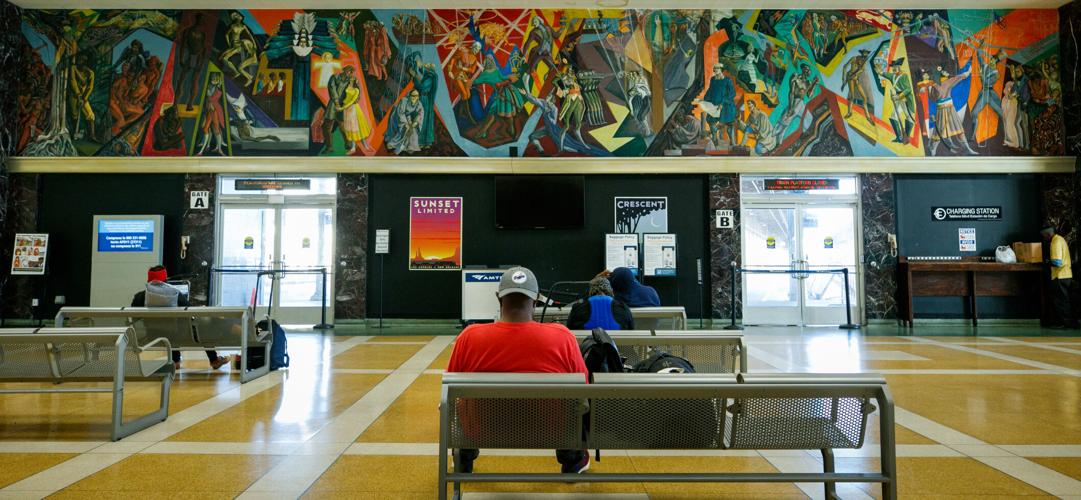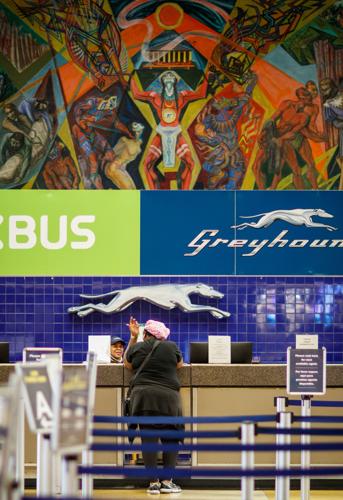On her journeys via Amtrak trains and Greyhound buses, Uptown New Orleans resident Miuna Mae has plenty of time to sit in the city's Union Passenger Terminal and look at a series of painstakingly detailed, colorful murals.
“I started thinking about it more, and the more that I sit there, the more interesting it becomes to me,” Mae said. “Like the little details, right? There’s radiant women standing there.”
Her question: What is the story behind the murals?

Conrad Albrizio's huge 1954 public art project at New Orleans' Union Passenger Terminal is meant to encompass the state’s entire history, to introduce the state to travelers stepping off the train. The four panels in the terminal depict The Age of Exploration, the Age of Colonization, the Age of Struggle, and the Modern Age. (Staff photo by John McCusker, The Times-Picayune | NOLA.com)
The huge project is the work of Conrad Albrizio, known for his large-scale frescoes. The four panels in the terminal depict “The Age of Exploration, the Age of Colonization, the Age of Struggle, and the Modern Age.” The intense, brightly-colored images of Louisianans are meant to encompass the state’s entire history, introducing the state to travelers stepping off the train. A whirlwind of boats, fields and people from all the ages are crammed in next to each other.
Decorating a sleek new terminal
Carolyn Bercier, author of “The Frescoes of Conrad Albrizio: Public Murals in the Midcentury South,” set the scene in New Orleans, in the early 1950s in a city recovering from WWII. Bercier said the city government, led then by New Orleans Mayor deLesseps "Chep" Morrison, commissioned Albrizio for the station work.
Bercier said Morrison wanted to revitalize New Orleans, and the terminal, complete with sleek design and imagery, was part of this vision.
“It was his (Morrison’s) desire to sort of modernize New Orleans, to kind of bring New Orleans forward,” Bercier said. “Here was this great transportation locale, and I think that was the real impetus. … He tries to bring in a lot of modern buildings and industry and so forth. And the Union Passenger Terminal was one of those.”

Conrad Albrizio's intensely colored 1954 murals depicting stages of Louisiana history loom over the ticket counters in New Orleans' Union Passenger Terminal.
Albrizio’s murals were unveiled to the public in 1954, adding to his repertoire of works in Louisiana. At that point, Albrizio’s work had been displayed throughout the state, seen in Allen Hall on the LSU campus, in the State Capitol, and on the side of a Shreveport museum, among other locations.
Enamored of the city's culture

Conrad Albrizio taught at LSU from 1936 to 1954. He is known for his public artwork, including frescoes in New Orleans Union Passenger Terminal. His fresco in Tivoli Place building at Harmony Circle recently has been recovered by art conservator Elise Grenier.
Born to an Italian immigrant family in New York City, Albrizio came to New Orleans through an architectural job in the 1920s, where he became enamored of the city’s culture. His first major commission was six frescos at the Louisiana State Capitol, and he joined Louisiana State University in 1936, becoming a formative member of the fledgling art department.
Many of his earlier works were commissioned through the Works Progress Administration. Throughout his career, Albrizio remained dedicated to the concept that art should be public and available to everyone.
Bercier described his earlier murals, like his Capitol pieces, as a realism-focused style, depicting daily life.
“His style changed through the years,” Bercier said. He worked prolifically for decades. "As the general artistic style changed in America, he sort of kept up with it.”
For his terminal work, Bercier said, he spent six months studying Louisiana before even starting to create larger sketches.
The artist died in Baton Rouge in 1973.
'The technique, it's amazing'

Conrad Albrizio's huge 1954 public art project at New Orleans' Union Passenger Terminal is meant to encompass the state’s entire history, to introduce the state to travelers stepping off the train. The four panels in the terminal depict The Age of Exploration, the Age of Colonization, the Age of Struggle, and the Modern Age. (Staff photo by John McCusker, The Times-Picayune | NOLA.com)
Art conservator Elise Grenier, who has restored and cleaned multiple Albrizio works across the state, described his painstaking approach and vivid color use, resulting in a product almost visually similar to stained glass.
“The technique, it's amazing,” Grenier said. “It's just like touching the wall of the Sistine Chapel. … It's like a piece of glass or a piece of marble. It's just extremely well troweled, really smooth, and just just real attention to the proportions, the quality of the ingredients and so on. His work is just so perfect.”
Grenier said the work was in fairly good condition, although she has noticed some areas that could be restored on recent trips to the panels — she herself has never worked on this particular piece. Grenier described the longevity of his work.
“It'll be here forever, long after we're gone,” Grenier said. “It'll last longer than a little wooden shotgun like my house, or anything else. These will be here, like the pyramids. They'll just last and last because of how well they were thought out and executed.”






